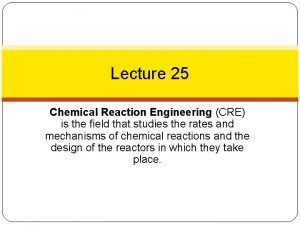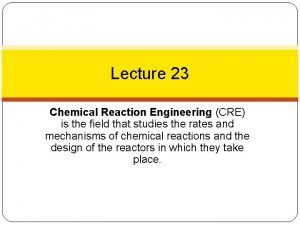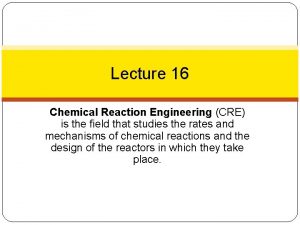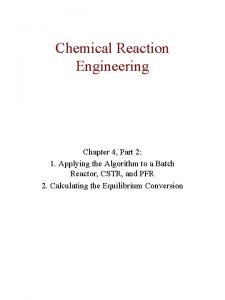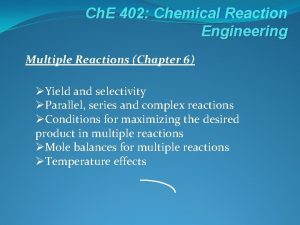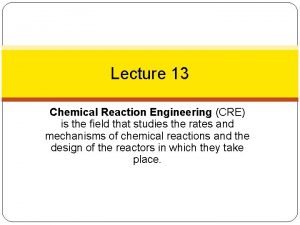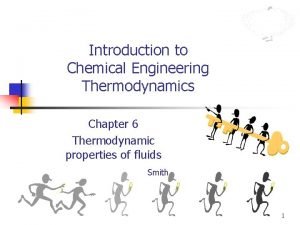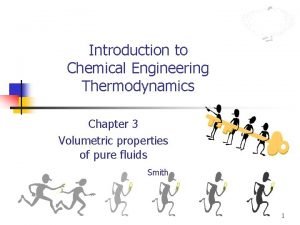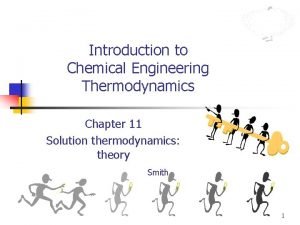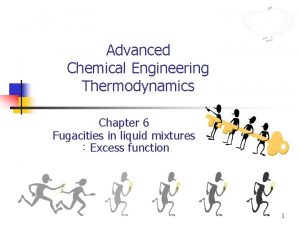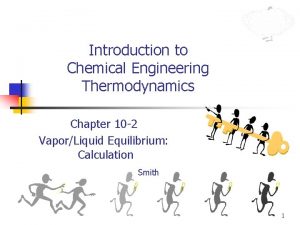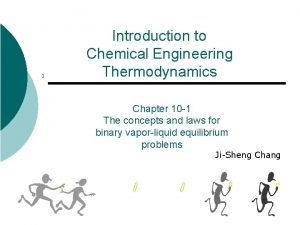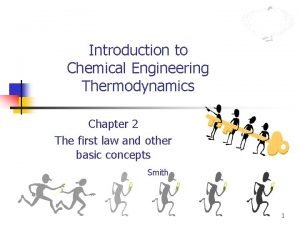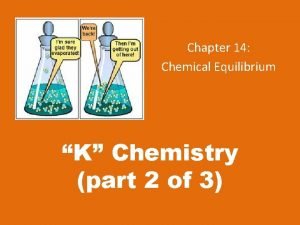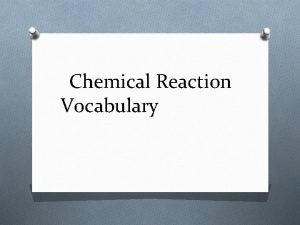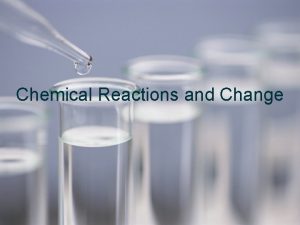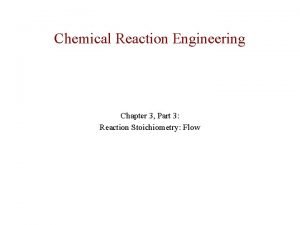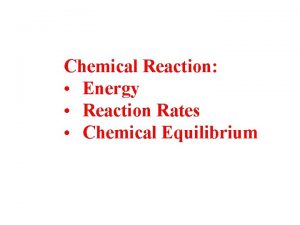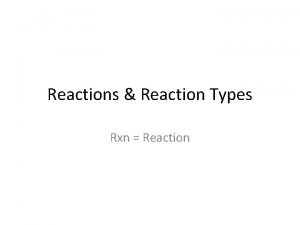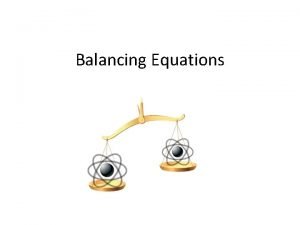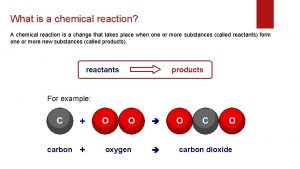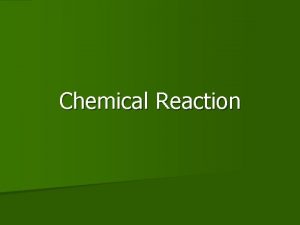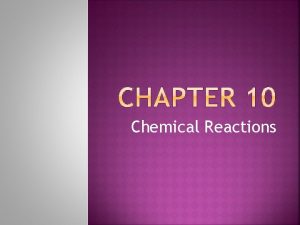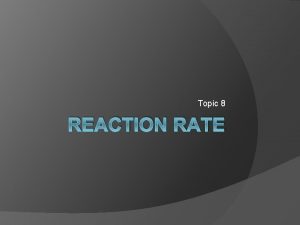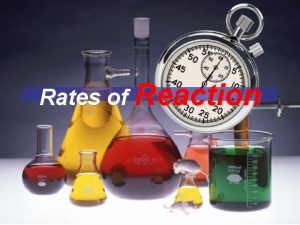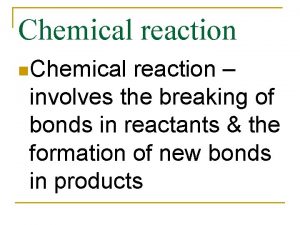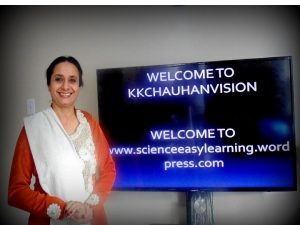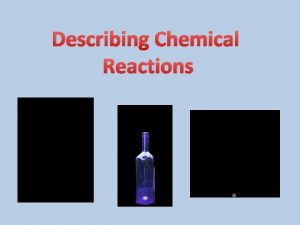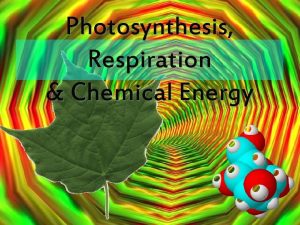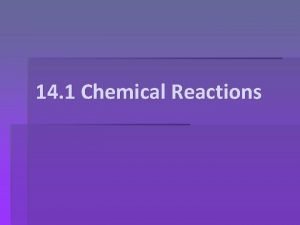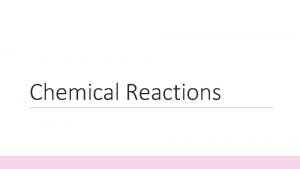Chemical Reaction Engineering Chapter 3 Part 4 Reaction























- Slides: 23

Chemical Reaction Engineering Chapter 3, Part 4: Reaction Stoichiometry Measures Other Than Conversion


Measures Other Than Conversion Uses: A. Membrane reactors B. Multiple reaction Liquids: Use concentrations, i. e. , CA

Measures Other Than Conversion Uses: A. Membrane reactors B. Multiple reaction Liquids: Use concentrations, i. e. , CA 1. For the elementary liquid phase reaction carried out in a CSTR, where V, vo, CAo, k, and Kc are given and the feed is pure A, the combined mole balance, rate laws, and stoichiometry are:

Measures Other Than Conversion Uses: A. Membrane reactors B. Multiple reaction Liquids: Use concentrations, i. e. , CA 1. For the elementary liquid phase reaction carried out in a CSTR, where V, vo, CAo, k, and Kc are given and the feed is pure A, the combined mole balance, rate laws, and stoichiometry are:

Measures Other Than Conversion Uses: A. Membrane reactors B. Multiple reaction Liquids: Use concentrations, i. e. , CA 1. For the elementary liquid phase reaction carried out in a CSTR, where V, vo, CAo, k, and Kc are given and the feed is pure A, the combined mole balance, rate laws, and stoichiometry are:

Measures Other Than Conversion Uses: A. Membrane reactors B. Multiple reaction Liquids: Use concentrations, i. e. , CA 1. For the elementary liquid phase reaction carried out in a CSTR, where V, vo, CAo, k, and Kc are given and the feed is pure A, the combined mole balance, rate laws, and stoichiometry are:

Measures Other Than Conversion

Measures Other Than Conversion

Measures Other Than Conversion 2. There are two equations, two unknowns, CA and CB

Measures Other Than Conversion • Gases: Use molar flow rates, i. e. , FI

Measures Other Than Conversion • Gases: Use molar flow rates, i. e. , FI

Measures Other Than Conversion • Gases: Use molar flow rates, i. e. , FI

Measures Other Than Conversion • Gases: Use molar flow rates, i. e. , FI

Measures Other Than Conversion • Gases: Use molar flow rates, i. e. , FI If the above reaction, , carried out in the gas phase in a PFR, where V, vo, CAo, k, and Kc are given and the feed is pure A, the combined mole balance, rate laws, and stoichiometry yield, for isothermal operation (T=To) and no pressure drop (DP=0) are:

Measures Other Than Conversion • Gases: Use molar flow rates, i. e. , FI If the above reaction, , carried out in the gas phase in a PFR, where V, vo, CAo, k, and Kc are given and the feed is pure A, the combined mole balance, rate laws, and stoichiometry yield, for isothermal operation (T=To) and no pressure drop (DP=0) are:

Measures Other Than Conversion • Gases: Use molar flow rates, i. e. , FI If the above reaction, , carried out in the gas phase in a PFR, where V, vo, CAo, k, and Kc are given and the feed is pure A, the combined mole balance, rate laws, and stoichiometry yield, for isothermal operation (T=To) and no pressure drop (DP=0) are: Use Polymath to plot FA and FB down the length of the reactor.

Measures Other Than Conversion Given: Use Polymath to plot FA and FB down the length of the reactor.

Measures Other Than Conversion Given: Use Polymath to plot FA and FB down the length of the reactor. FA FB V

Summary At the start of the chapter we saw we needed -r. A=f(X). This result is achieved in two steps.

Summary At the start of the chapter we saw we needed -r. A=f(X). This result is achieved in two steps. 1. Rate Laws – -r. A=k f(Ci) – 1 st order A--> B -r. A=k. CA or 1 st order

Summary At the start of the chapter we saw we needed -r. A=f(X). This result is achieved in two steps. 1. Rate Laws – -r. A=k f(Ci) – 1 st order A--> B or 1 st order -r. A=k. CA – 2 nd order A+B --> C -r. A=k. ACACB – Rate laws are found by experiment

Summary At the start of the chapter we saw we needed -r. A=f(X). This result is achieved in two steps. 1. Rate Laws – -r. A=k f(Ci) – 1 st order A--> B or 1 st order -r. A=k. CA – 2 nd order A+B --> C -r. A=k. ACACB – Rate laws are found by experiment 2. Stoichiometry – Liquid: – Gas:
 Proton capture equation
Proton capture equation Chemical reaction engineering
Chemical reaction engineering Chemical reaction engineering
Chemical reaction engineering Chemical reaction engineering
Chemical reaction engineering Chemical reaction engineering
Chemical reaction engineering Multiple reaction example
Multiple reaction example Chemical reaction engineering
Chemical reaction engineering Chapter 7 chemical formulas and chemical compounds test
Chapter 7 chemical formulas and chemical compounds test Trinitrogen monosulfide formula
Trinitrogen monosulfide formula Chapter 18 chemical reactions balancing chemical equations
Chapter 18 chemical reactions balancing chemical equations Chemical engineering thermodynamics 8th solution chapter 6
Chemical engineering thermodynamics 8th solution chapter 6 Chemical engineering thermodynamics 8th solution chapter 3
Chemical engineering thermodynamics 8th solution chapter 3 Thermodynamics for chemical engineering
Thermodynamics for chemical engineering Chapter 6
Chapter 6 Chemical engineering thermodynamics 8th solution chapter 10
Chemical engineering thermodynamics 8th solution chapter 10 Duhem theorem
Duhem theorem Introduction to chemical engineering thermodynamics
Introduction to chemical engineering thermodynamics Section 2 reinforcement classifying chemical reactions
Section 2 reinforcement classifying chemical reactions Chemical reactions section 2 classifying chemical reactions
Chemical reactions section 2 classifying chemical reactions Chemical reactions section 1 chemical changes
Chemical reactions section 1 chemical changes Chemical part 2
Chemical part 2 Chapter 10 chemical reactions
Chapter 10 chemical reactions Chapter 9 chemical reactions answers
Chapter 9 chemical reactions answers Chemical names and formulas chapter 9
Chemical names and formulas chapter 9

